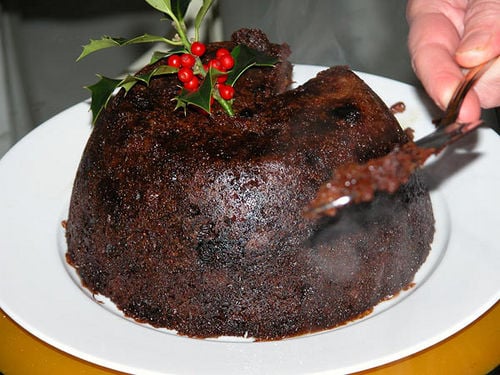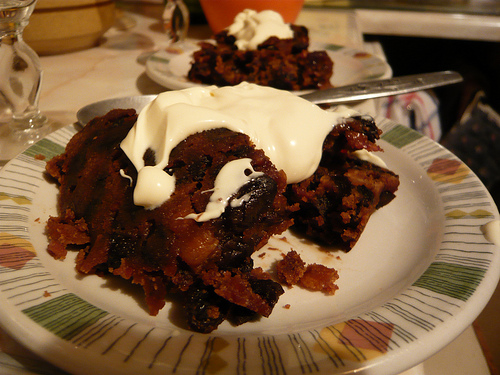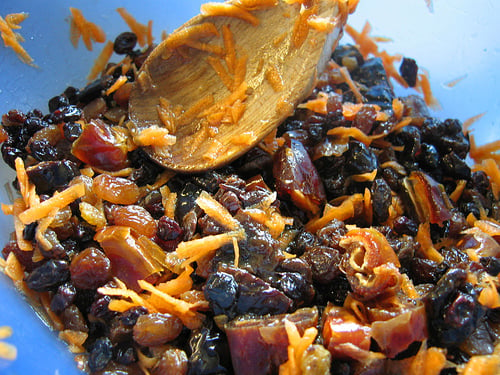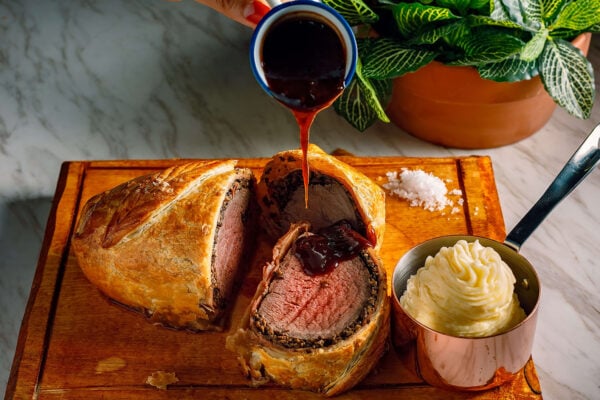
A British holiday tradition – Christmas pudding
Christmas lunch is drawing to a close. Participants have indulged in slabs of roast turkey, lashings of gravy and bread sauce and piles upon piles of roasted root vegetables smothered in a blanket of Brussels sprouts. Obviously the most serious person at the table will be sporting a paper crown from their Christmas cracker. The heady indulgences of the day are surely coming to a close. For the good of your gut flora and arteries maybe now would be a good time to have a palate-cleansing sorbet, possibly a clementine or a bucket of an aniseed-based digestif.
Weeeellll, any other day of the year and probably in any other nation on earth that’s what would happen. But not in Britain. Oh no. For now is the time to unleash the Christmas Pudding. Ideally smothered in brandy and flaming (yes, I said FLAMING) as it makes its way to the table, arguably the gastronomic pièce de résistance of the day.

The grand finale … the flaming Christmas pudding!
And rightly so. For this rich, fruity, stodgy, boozy heap of yumminess has been about a thousand years in the making. In the depths of the Medieval period, well before “refrigeration” was anything other than a corruption of a Latin infinitive, peasants, middling sorts and aristocrats all had to keep enough food through the hardships of winter. One way to preserve meat was smothering it with alcohol, spices and dried fruits, sometimes encasing the whole lot in pastry. These puddings were then stored away until the time came for their consumption.
But those clever Medieval Christians had the rather fun idea of combining the necessity of preparing all this food with the jolliness of Advent and the run up to Christmas proper. Tradition has it that a Christmas pudding should include thirteen ingredients (a reference to Christ and the 12 Apostles) and that all members of the family from the most aged to the tiniest should give the pudding mixture a stir from East to West.
Rather like a very miniature version of the Magi’s journey from East to West. But with more sticky fruit and fewer camels.
To give a degree of formality to this tradition, from the 16th century the Sunday before the beginning of Advent became known as Stir-up Sunday. This provided a good five weeks for the pudding to hang and reach a flavorsome maturity before the final 6 to 8 hour steaming on Christmas Day.

Christmas puddings waiting patiently for their moment of glory
And so the centuries rumbled on with generation after generation creating various versions and regional reinterpretations of Christmas puddings … until along came the Victorians. By 1830 meat was no longer a key ingredient, aside from the suet needed to bind the pudding together, and there was a much larger emphasis on the sweeter elements. Lucky charms like pennies and thimbles were stirred in the mixture, waiting to be discovered when the pudding was finally brought forth on Christmas Day. Oh what larks! One word of warning: the accompanying custard, double cream, brandy butter or all three together are excellent at camouflaging these pennies so be careful not to eat them.

Christmas pudding with brandy cream
Today you can buy a ready-made Christmas pudding almost anywhere. Indeed, I had a chum whose summer job at university was working in a Christmas Pudding factory. It was certainly one of the odder ways of paying for the student loan, but it meant no dearth of candied citrus peel, dried raisins and lashings of brandy in his student digs.

Making your own Christmas pudding at home
If you fancy having a go yourself rather than succumbing to the ease of a swift Christmas Pudding purchase, then do follow GoodHousekeeping’s helpful step-by-step Christmas pudding instructions. Or if Christmas Eve has crept up on you but you’re still feeling ambitious then consult the Queen of British TV Cookery, Delia Smith, for a speedier recipe. Delia’s amazing. She’s like Martha Stewart but owns a soccer club instead of a soft furnishing empire. She may warrant a blog post at some point in the future, dear London Perfect readers.
For now, I wish you good speed and much enjoyment with your Christmas Puddings. Be careful not to singe those eyebrows when you finally present your pudding en flambé.
_____________
Zoë F. Willis is a London Perfect reservationist, writer and Londoner. Visit her blog Things Wot I Have Made to find out more about Zoë’s many creative talents!
Photo Credits: Christmas pudding by James Peek, Flaming Christmas pudding by John, Tied up Christmas puddings by Simon Pearson, Christmas pudding with Brandy cream by Jessica Spengler, Christmas pudding ingredients by Simon Pearson




[…] which, a bit like Christmas pudding, involves a lot of dried fruit and mixed spice. But with marzipan to boot. […]